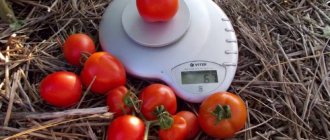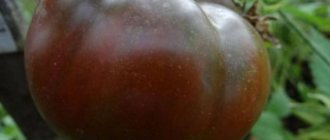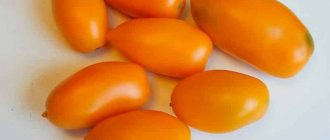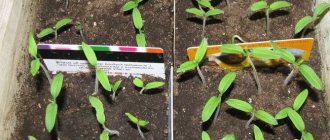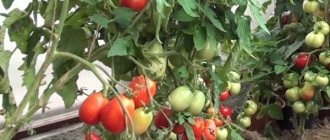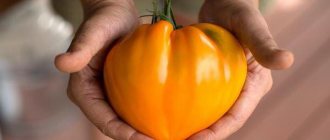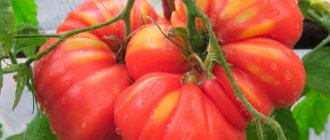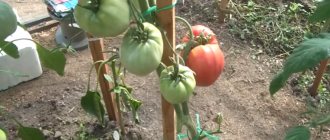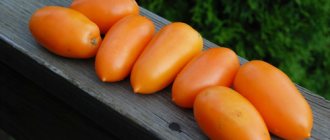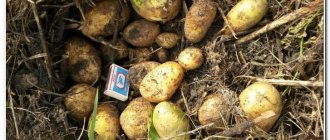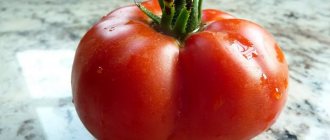History of the variety's creation
This tomato variety was bred by Siberian breeders who strive to develop varieties of vegetable crops to grow specifically in the harsh Siberian climate.
Work on breeding this variety of tomatoes was carried out at the end of the last century. After the tests, this tomato was included in the Russian State Register in 2000. It was named after the main character from the story of Maxim Gorky, who walks with a flaming heart in his hands and illuminates the path for other people.
This tomato is zoned for cultivation in Siberia, the Urals, in the middle zone and can very well tolerate low temperatures during the growing season, lack of sunlight, does not require a special soil composition, and can easily withstand any weather changes.
Useful video
Watch the video: the most delicious, productive, unpretentious varieties of tomatoes
| Early ripening | Mid-late | Mid-early |
| Raspberry Viscount | Yellow banana | Pink Bush F1 |
| The Tsar Bell | Titanium | Flamingo |
| Kate | Slot F1 | Openwork |
| Valentina | Honey fireworks | Cio Cio San |
| Cranberries in sugar | Miracle of the market | Supermodel |
| Fatima | gold fish | Budenovka |
| Verlioka | De Barao black | Major F1 |
If you find an error, please select a piece of text and press Ctrl+Enter.
Description and characteristics of the variety
Tomatoes of this variety belong to the determinate type, so the central shoot of the bush has an endpoint of growth - at its top not foliage grows, but an inflorescence with ovaries. Bushes of the Danko variety are low and compact, can reach 49-51 cm in height, side shoots are formed in small quantities.
Danko tomato can be grown both in beds in the garden and in greenhouse conditions, where they can grow up to 1.10-1.15 m. According to the ripening period, these tomatoes are classified as mid-early - from the moment of germination of the seed material to the harvesting of ripe fruits, it takes incomplete 4 months. This tomato is formed into 3-4 shoots, and the yield increases significantly.
These bushes do not need to carry out the pinching procedure. When growing the Danko tomato variety in greenhouse conditions, it is necessary to tie the tufts to supports. Ripe tomatoes of this variety are heart-shaped, the surface is even, smooth with slightly noticeable ribbing. The skin is thin, during ripening it is light green in color, and as it ripens it becomes orange with a red tint. Even after full ripening, the stalk retains a dark emerald-colored spot.
The pulp is compacted, sugary, with a very sweet taste. The weight of ripe fruits when grown in garden beds is up to 240-264 g, when grown in greenhouse conditions - up to 360-390 g. The largest fruits ripen in the lower part of the bushes. The commercial quality of ripe fruits is good.
The skin of ripe tomatoes is not too thick, so the fruits are prone to cracking, do not tolerate transportation well over any distance, and cannot be stored for a long time. The Danko tomato is considered a salad variety due to its sweetish taste. Therefore, they are eaten fresh, added to salads, and prepared as snacks.
This variety is characterized by good resistance to heat and periods of drought, and can easily tolerate temporary drops in temperature, which is why it is actively grown by vegetable growers in Siberia.
Features of cultivation and storage
The Danko variety is one of the easiest to care for and resistant to various external factors (like the Mushroom Basket tomatoes or the Super Klusha variety). It tolerates drought well without needing regular watering. This variety is also quite resistant to pests and diseases. Many fungal diseases that affect other tomatoes are not dangerous for the Danko variety.
Tomato variety "Danko" does not need regular watering, tolerates drought well, and is not susceptible to many fungal diseases
The Danko variety was developed in Russia. It gives high yields in all regions. To get the best results from growing such fruits on your own plot in the coldest areas, it is recommended to plant them not in open ground, but in winter greenhouses. Here it will be reliably protected from various unfavorable external factors and will be able to produce a good harvest.
In cold areas, Danko variety tomato should be grown in winter greenhouses
The advantages of the Danko variety include:
- compactness of bushes;
- ease of plant care;
- fruit fleshiness;
- pleasant taste of tomatoes;
- rapid ripening of already harvested tomatoes.
The advantage of the Danko tomato variety is the compactness of the bush
Read about how to tie cucumbers in a greenhouse here.
The tomato variety Danko is determinate or semi-determinant. In open ground it reaches 60-70 cm, and in a greenhouse it grows to 150-180 cm. Ripening period is mid-early or mid-season. The harvest is harvested 110-115 days after emergence.
The shape and color of Danko tomatoes resemble a bright red heart. The name of the variety is connected with this: according to legend, a young man named Danko saved his people - he led them out of the dark forest, lighting the way with a fiery heart.
Tomatoes are great for cutting and making salads. They are a delicious snack to eat just like that, between main meals.
Juicy fruits are often used for sauces, pastes, ketchups, and juices. They are not suitable for canning.
Productivity
For a determinate variety, the yield is very high. 3-4 kg of tomatoes are harvested from each low-growing bush. When grown in a greenhouse, tall bushes are obtained, each of which produces 5-6 kg of fruit.
There is no reliable data on increased immunity, however, according to reviews from gardeners, Danko tomatoes get sick no more often, if not less often, than other varieties.
Due to the sweet large fruits, the tomato is a tasty bait for insect pests (which is why regular inspection of the bushes for damage is so important).
Tomatoes love loose sandy soil or loam. Compost, superphosphate, and wood ash are added to the beds.
How to grow:
- formation is carried out in 3-4 stems;
- tied to pegs;
- water moderately 2 times a week;
- loosen and remove weeds;
- mulch with a layer of 7-8 cm.
Fertilize once a month, fertilizing is carried out during flowering, setting, and ripening of tomatoes. Use 1:10 diluted bird droppings, mullein. Minerals you will need are superphosphate and potassium salt.
Advantages and disadvantages
The main advantages of this tomato variety include:
- early ripening of the crop;
- the variety does not require pinching;
- fairly large fruit size;
- these tomatoes are suitable for growing not only in garden beds, but also in greenhouse conditions;
- good taste of ripe fruits and excellent presentation;
- the bushes of this tomato can tolerate not only low temperatures, but also extreme heat and periods of drought;
- unripe fruits of the Danko variety grow well indoors;
- high resistance to diseases and pest attacks;
- Danko tomato bushes are not susceptible to late blight.
But this tomato also has a number of disadvantages:
- the skin is too thin, so the tomatoes are prone to cracking, do not tolerate transportation well, and cannot be stored for a long time;
- The yield of this tomato is below average, so the variety is not suitable for growing on an industrial scale.
Danko tomatoes on video
If you grew Danko tomatoes, please write whether you liked them or not. What was the yield and taste of the fruits in your climatic conditions? Would you grow them again and recommend them to others? Briefly describe the advantages and disadvantages of this tomato in your opinion. If possible, attach to the comment a photo of the entire bush as a whole or individual ripe fruits that you grew. Thank you!
Your reviews of the Danko tomato and additions to the description will help many gardeners evaluate this variety objectively and decide whether it is worth growing or not.
You can see other interesting varieties and hybrids of tomatoes with photos, descriptions and reviews in our Tomato Catalog. Enjoy watching.
Growing seedlings
You can buy a mixture for growing seedlings at a specialty store, or prepare it yourself.
To do this, mix equal parts of garden soil, sawdust (or peat), and coarse sand. Also added to this mixture are mineral fertilizers containing potassium and phosphorus, or any organic matter - ash, lime or humus.
Seedlings are picked at the stage of 2-3 true leaves. This procedure prevents the seedlings from being pulled out and also stimulates the growth of lateral roots in the root system of the seedlings.
When growing seedlings, it is necessary to provide them with sufficient lighting so that the stems do not stretch too much - such seedlings as a result grow weaker and bear fruit worse.
During the growing of seedlings, they need to be fed with urea a couple of times for more active growth of the above-ground parts and roots. The first time, fertilizer is applied 10-12 days after the picking, the second time - 12-14 days before transplanting the plants to a permanent place.
A couple of weeks before planting seedlings in a garden or greenhouse, you should begin to harden them. To do this, containers with seedlings begin to be taken out into fresh air, first for 1-1.5 hours, gradually increasing the time the seedlings are outside.
Strong seedlings should be transplanted into garden beds when the air temperature warms up to +11+12 degrees Celsius, and the threat of severe night cold snaps has passed. In Siberia, seedlings should be transplanted in early June.
The planting scheme for these vegetable plants is at least 4 plants per square area, but bushes can be planted more densely. Seedlings can be transplanted into greenhouse conditions in the second ten days of May. in a greenhouse, bushes of the Danko variety are planted more freely, since in greenhouse conditions these plants grow stronger.
Agricultural techniques
The technology for growing this variety depends on the region, all because the timing of planting plants in the soil will change. And although tomatoes of this variety are considered unpretentious, this does not mean that it does not need to be given attention at all.
Landing rules
For regions of Russia, cultivation exclusively by seedlings is suitable. Therefore, first of all, you should sow seeds to obtain it.
Sowing dates will also vary depending on the region. For example, in the central regions of the country this is done in early March.
If you purchased unprocessed planting material and also collected it yourself, you must meet some conditions:
- rejecting empty seeds;
- warming up;
- treatment with potassium permanganate solution;
- You can also stimulate the acceleration of the appearance of sprouts with special preparations;
- germinate exclusively in a warm, humid environment.
Sowing of seeds is carried out in loose and nutritious soil. The soil mixture can be purchased at a specialty store, or you can make it yourself. To do this, take garden soil, mix it with peat or sawdust, add sand, mineral fertilizers such as phosphorus and potassium.
When the first 2-3 true leaves appear, the seedlings should be planted in a large container.
Important! Before planting plants in open beds, seedlings should be hardened off. This will help her adapt more easily after landing.
Tomatoes are planted in open beds only when the soil warms up to +10 degrees
It is important that the threat of frost has passed. The most optimal scheme is 4 plants per 1 sq.m. Tomatoes are planted in open beds only when the soil warms up to +10 degrees
Tomatoes are planted in open beds only when the soil warms up to +10 degrees
It is important that the threat of frost has passed. The most optimal scheme is 4 plants per 1 sq.m. If you plan to plant plants in a greenhouse, seedlings can be planted around the 20th of May
If you plan to plant plants in a greenhouse, seedlings can be planted around the 20th of May.
Landing
The Danko tomato can bear fruit even under negative weather conditions, but in this case the yield of the variety will be significantly lower. And in greenhouse conditions, tomato bushes grow stronger and more powerful, so they should be tied to supports.
In addition, it should be remembered that this variety is intended only for fresh consumption, so you should not plant too many Danko tomato bushes.
In most Russian regions, tomatoes of this variety are grown only by seedlings. It is necessary to plant seed for seedlings depending on the weather conditions of a particular region. In the central regions of the country, you can plant Danko seeds for seedlings already in the first days of March, and they need to be prepared for planting in the last days of February.
It is better to purchase the seeds of this tomato from well-known seed manufacturers, who package the seeds in bags that are already fully prepared for sowing.
When collecting seed from your tomatoes or purchasing untreated seeds before planting, prepare them as follows:
- empty seeds are discarded;
- warm them up;
- place the seed material in a weak solution of potassium permanganate for disinfection;
- then the seed material is soaked in Epin solution to stimulate growth;
- placed in damp gauze for a day for germination.
The seed material that was collected more than 3 seasons ago should be subjected to a stratification procedure - placed in the refrigerator for some time.
What actions are included in the agricultural technology of growing tomatoes?
Many amateur gardeners believe that all care for tomato beds consists of watering and weeding. In fact, with such scant attention, even the most fertile and disease-resistant hybrids will not produce high yields. Let's try to understand in more detail the generally accepted rules for growing tomatoes.
Agricultural technology for growing tomatoes consists of the following points:
- selection of seeds (in particular varieties) - certain varieties of tomatoes are suitable for each region;
- preparing seed for planting (soaking for the purpose of disinfection and growth stimulation);
- creating conditions for growing seedlings (lighting, temperature, watering, fertilizing);
- picking seedlings;
- choosing a place for a garden bed and preparing the soil;
- transplanting seedlings into beds;
- watering;
- fertilization;
- disease prevention;
- weeding and loosening the soil;
- formation of bushes and pinching, tying up tall plants (even if the tomato is short, you should not deviate from these rules);
- harvesting.
In addition to the main stages, additional measures are used to promote better cultural development:
- mulching the beds;
- treatment of seedlings with growth stimulants;
- construction of a temporary shelter for protection from spring frosts (from film or agrofibre);
- planting crops in the neighborhood that drive away pests.
Further care
Although this variety is considered quite unpretentious, this does not mean that the plants can be planted and forgotten about until the ripe fruits are collected. These tomato bushes need to be watered as the soil dries out in the evening. Water for irrigation should be warm and filtered. Although the variety can easily tolerate periods of drought, this negatively affects the formation of ovaries and the ripening of fruits.
It is necessary to form bushes of this variety as follows: remove all shoots except the three or four lower ones. If this is not done, the fruiting of the bushes will be less than stated.
The soil around the tomatoes is regularly loosened, simultaneously removing weeds. When the first signs of disease appear, it is necessary to immediately treat the bushes with appropriate fungicidal preparations.
Those bushes that are grown in a greenhouse should be tied up so that the shoots do not break off under the weight of ripening fruits.
Heart-shaped fruits
The Danko tomato is not a hybrid. You can easily get your own seeds by saving typical tomatoes from the most generous bushes.
Bright color
When fully ripe, the fruits acquire a rich blood-red color. Unripe tomatoes of the Danko variety have a dark green spot near the stalk, which completely disappears when ripe.
In the conditions of the Middle Zone, in Siberia, in the Urals, in the open air, from a third to half of the crop turns red on the vine. The rest of the tomatoes ripen well in storage. Greenhouse conditions allow you to remove all the fruits that are red or brown.
Salad pulp
The most important quality of Danko tomatoes is the excellent taste of the fleshy fruit. Under the thin skin lies a sugary pulp with a small amount of seeds. The consistency is moderately juicy, but not liquid. Tasting score: 10 points out of 10 possible.
Solid size
The description of the variety as large-fruited is fully justified: the weight of one tomato in the first bunch can reach 0.5 kg. Even the ovaries in the uppermost racemes do not grow less than one hundred grams. On average, tomatoes stretch 170 - 300 g. Each bush is capable of carrying 2 - 3 dozen full-sized “hearts”.
Significant return
The minimum yield of the variety is 4 kg per square meter. This number is only valid for open ground in the northern regions. The potential is much higher: it all depends on the growing conditions. You can remove 4–5 kg from a bush, and this is not the limit either. Greenhouse conditions and competent agricultural technology make it possible to obtain 6–7 kg of fruit from one plant.
The Danko variety of tomato has one amazing property - a clear contrast between the crop load and the size of the plant. The bushes look delicate, even frail, the foliage is rather weak, and against this background there is a record weight of fruits.
Reviews
Tatyana, 45 years old, Chelyabinsk : I have been planting the Danko variety in my garden plot for several years now. In our climate, it is difficult to choose pink varieties of tomatoes that could be grown in open ground; all of them are intended for growing in a greenhouse, which I do not yet have on the site. And Danko is also suitable for growing in our region in garden beds. True, I don’t plant many bushes of this variety, since its fruits are only suitable for food and do not last long, they begin to deteriorate. But the taste of picked Danko tomatoes is excellent.
Olga, 55 years old, Samara region : I grow Danko tomatoes along with several other varieties of early tomatoes in my garden. I like this variety because of its beautiful appearance and good taste of ripe fruits. Although the tomato is resistant to periods of drought, in hot weather it is better to water the Danko bushes more often, otherwise the fruits will grow smaller and their taste may deteriorate. During the season I always feed this variety with organic fertilizers, in which case its yield increases.
Description of tomatoes
Tomato Yusupovsky from the Uzbekistan family. The variety is intended for cultivation in greenhouses. Description of Yusupov tomatoes - tall fruits and late ripening. The tomato itself is large in size and quite meaty. It is characterized by a pink (slightly red) color. The weight of one fruit is 400-600 g. The Uzbek tomato, its genus was created by breeders of the Uzbek Research Institute. He was named after the famous breeder Karim Yusupov. This variety is the best of all large tomatoes.
A tomato bush reaches a height of 1.8 m. If you plant seedlings in open ground, then the bush will grow only 60 cm. During growth, the plant must be tied up. The leaf is ordinary, it is advisable to form it into 2 stems. In addition, the plant is pruned for better yield. Planting of seedlings is carried out in June or July. After this, after 60-65 days you can harvest a wonderful harvest.
Benefits of Yusupov tomatoes
Yusupov tomatoes grow very tasty. They grow well in the south of the country and in the north. Because of their large fruits, Uzbek tomatoes resemble hybrids, but this is not the case. Every year the seeds change, but still retain all the qualities of a wonderful tomato. The center has a dessert taste, juicy and very sweet. There is not even any sour tones in the tomato.
Tomatoes are well suited for making salads and eating fresh. They will make very tasty and sweet juice. The fruits do not like to lie for a long time after picking, so they are eaten immediately.
The best determinate varieties of tomatoes for open ground
Determinate varieties of tomatoes are convenient to grow in open ground. They do not need such high support as tall varieties need, and if they need formation, it is minimal. Experienced agronomists advise new farmers and gardeners to start growing tomatoes with indeterminate varieties. In addition, low-growing tomatoes usually ripen quickly and smoothly, and therefore they are perfect for regions with short summers.
If you are looking for a suitable variety of low-growing tomatoes, then you can definitely choose something from the options offered below. We have selected for you the best determinate varieties of tomatoes for open ground.
The best low-growing tomato varieties for exhaust gas
Rio Grande
A variety of Dutch selection, the bushes of which can reach 50-60 centimeters in height in open ground, and the inner part of the medium-sized plum-shaped fruits has good elasticity. Thanks to this, they are perfectly stored and are suitable for pickling and drying.
Determinate tomato Rio Grande
Bobcat
This variety was developed by the Dutch, endowing it with excellent commercial qualities. Large and beautiful fruits have a high dry matter content, which makes them suitable for long-term transportation. Bobcat tomatoes are suitable for growing in open ground exclusively in the southern regions. They have good immunity and long-term fruiting.
Tomato Bobcat
Linda
One of the new determinate varieties of tomatoes. The fruits are quite large and dense - ideal for salads and store well. A strong plant is rarely infected with various diseases and, with proper care, always produces an excellent harvest.
Tomato variety Linda
Mystery
The main trunk reaches a height of 45 cm and is quite strong so that the tomato does not fall without a garter. However, regular stepsoning is necessary. Riddle is an ultra-early variety. The fruits reach a weight of 150 g, beautiful and dense.
Beautiful Danko tomato fruits
Petrusha the gardener
This variety is one of the last fruits of the labor of Siberian breeders. By growing it, you don’t have to waste time and energy on planting. Its fruiting period is long, its yield and drought resistance are quite high, and its fruits are universally used. The 60-centimeter bush looks very elegant in an area of open ground.
Parsley gardener - an elegant tomato bush for open ground
Danko
A tomato with large heart-shaped fruits covered with a thin peel. Height - 50 cm, the bush needs to be formed and strengthened. It has good drought tolerance and excellent taste. Productivity is average, transportation is not advisable.
Heart-shaped tomato variety Danko
Crimson Giant
This hybrid has truly gigantic raspberry fruits. The average height of the bushes is 70 cm. The fruits ripen early, so late blight cannot overcome them. The greatest advantage is the highest productivity.
Huge fruit of the Raspberry giant variety
Roma
Determinate variety of tomatoes of medium ripeness with plum-shaped fruits of high quality. The plant is standard - a garter may not be required. This hybrid is usually grown for canning.
Roma - tomato for canning
Summer resident
Gardeners love the tomato for its unpretentiousness, endurance of low temperatures, and consistently high yield. Fruit ripening is early. The height of the bush is half a meter.
Summer resident - an unpretentious tomato for open ground
The best determinate varieties of tomatoes for open ground, in our opinion, should not be left out of your attention. Try to grow at least one of the proposed varieties on your plot of land, and you will not have to regret your choice. Of course, if all the necessary planting and care rules are followed.
Diseases and pests
The Danko variety is not susceptible to such traditional tomato diseases as gray rot of tomatoes, mosaic and late blight on tomatoes. They can develop in this plant only if they are transferred from neighboring beds with other varieties of tomatoes. To prevent the occurrence of such diseases, it is recommended to plant tomatoes far from crops of the nightshade family and carry out preventive treatment with special agents against diseases.
As for pests, these plants are most often affected by mole crickets, wireworms, and cutworms. These pests must be removed using special preparations such as “Thunder”, “Strela” and others. It is best to take combined mixtures that will not only rid the seedlings of existing parasites, but will also help prevent their appearance in the future.
It should be remembered that fruits affected by diseases or pests cannot be eaten in any form. As for diseased bushes, they need to be immediately removed from the rest of the plants. If they are damaged by rot, it is better to remove the plants from the beds altogether.
